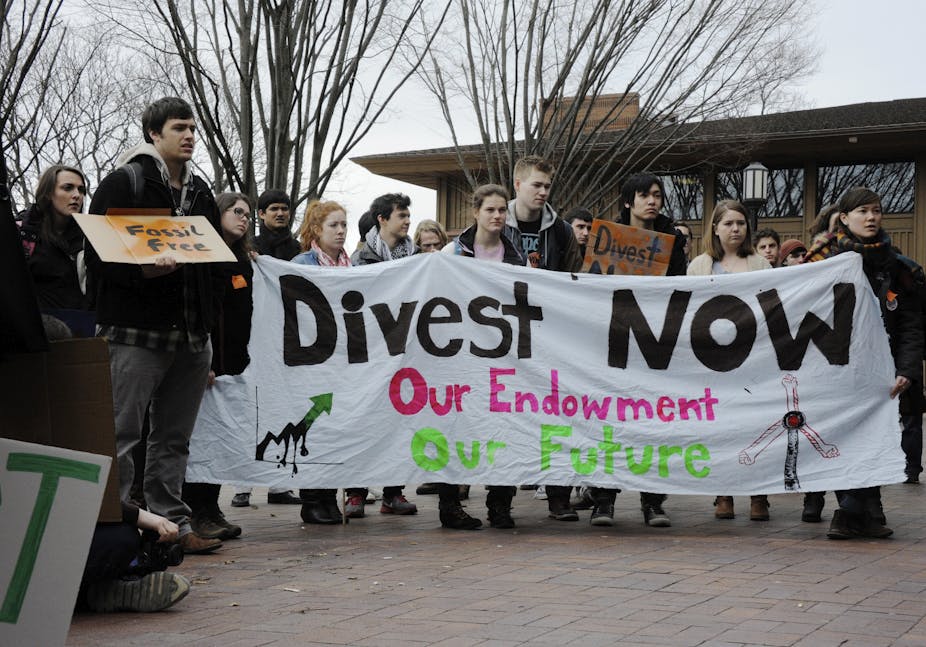The launch of Future Super, which claims to be the first super fund in Australia to exclude fossil fuels and their major supporting companies from its investment portfolio, has drawn significant attention. It raises two important questions: do strategies to divest from fossil fuels work? And can such a fund deliver financial performance as well as social and environmental impact?
Lets start with the first question. Future Super has divested of fossil fuels, directing its investments into renewables instead. And while it may be the first Australian super fund to do this on a blanket basis, similar steps are being taken around the world.
Earlier this year, Stanford University made headlines with its decision to divest of its coal interests. US universities command huge endowment funds, and Stanford’s decision redirected US$18.7 billion (A$20.3 billion) away from some 100 publicly traded coal companies (although the university has continued to invest in oil and gas).
The move was hailed as a milestone for fossil fuel divestment, reflecting both Stanford students’ concerns over climate change and a broader desire across the United States to invest in alternative energy. The divestment movement is thought to be active at about 400 other US colleges and universities.
While not a total divestment of fossil fuels, Stanford’s decision has undoubtedly added significant profile and momentum to the movement, not to mention posing a public relations challenge to America’s richest university, Harvard. The movement has been described as akin to the anti-apartheid drive of the late 1970s and 1980s, when student protests persuaded universities and colleges to boycott companies linked to South Africa’s regime. The rest is history.
Staying inside the tent?
Yet others argue that divestment strategies don’t work because they don’t have the capacity to inflict significant economic damage on huge coal companies. In a New York Times editorial titled “Why divestment fails”, UCLA economist Ivo Welch argued that:
Even if Stanford divested itself fully of all its stocks, both fossil and non fossil, it would probably take the market less than an hour to absorb the shares. It would not lead the executives of the affected companies to engage in soul-searching, much less in changes in operations.
Welch suggested that Stanford could have more impact by doing a complete about-face, concentrating its holdings in coal companies and then using its increased power to press corporate boards to make changes. (Welch also argued that divestment was not a significant pressure on the South African government’s decision to overturn apartheid.)
Yet while the efforts of Future Super, Stanford and others may not cause fossil fuel companies to close up shop in the short term, branding these industries as pariahs does contribute to changing public attitudes on energy policy and behaviour.
Meanwhile, the hard economics are changing too. Growing environmental regulation of greenhouse emissions, and the availability of other sources of energy, will make coal company stocks less attractive than they once were. So with an uncertain long-term value, it’s reasonable to expect increasing numbers of superannuation investors seeking to avoid what may well become “stranded assets”.
Money and morals
The move away from fossil fuel investment is consistent with global trends for “impact investing”, which aims to deliver both financial and social/environmental returns.
According to the World Economic Forum, this emerging market is forecast to be worth between US$450 billion and US$650 billion by 2020. “Social stock exchanges” have been set up in London, Singapore, and Ontario to trade in companies that offer social benefits as well as profit.
New legal corporate structures are also being set up to achieve these dual impacts. The US state of Delaware, where many Fortune 500 firms are registered, has passed a law that allows companies to officially categorise themselves via a legal structure as publicly beneficial. Twenty-five other states have now followed suit.
There is also a growing corporate certification movement whereby corporations can be certified as providing public benefit. Separate to having a formal Benefit Corporation legal structure, so-called “B-Corporations” are certified by B-Lab, which verifies a corporation’s social and environmental performance, thereby assisting in providing due diligence for prospective impact investors.
B-Corporations are increasingly becoming a feature of the Australian corporate landscape, although Australia currently lacks the option of a formal legal corporate structure. Even ratings agencies like Moody’s are moving into this space.
Ethical investment is here to stay
In short, more and more investors want these types of opportunities, for both financial and moral reasons. An Australia Institute report last year found that one in four Australians would be willing to shift their superannuation into a fund that doesn’t invest in coal or coal seam gas, amounting to about A$247 billion that could be moved away from fossil fuels.
While the divestment movement may take time to gain real traction, it is growing. Investor attitudes and preferences will shift yet further as the evidence mounts that corporations and investors can have their cake and eat it, securing both financial and social or environmental returns.
Funds like Future Super are putting themselves in a competitive global position, by reducing the likelihood of ending up with stranded fossil fuel assets. Given the impending transfer of US$30 trillion in wealth from Baby Boomers to Millennials, and the fact that half of Millennials want to use their wealth to help others as well as themselves, the idea of using investment capital to address environmental and social concerns while still delivering financial results is slowly but surely becoming mainstream.

